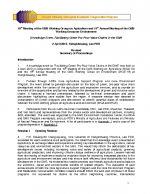
Proceedings of the Thirteenth Meeting of the GMS Subregional Transport Forum
The Thirteenth Meeting of the Subregional Transport Forum (STF-13) was held in Siem Reap, Cambodia on 27-28 October 2009. The Meeting was jointly organized by the Ministry of Public Works and Transport of Cambodia and the Asian Development Bank (ADB).







